Inside an Amish Home With Some Surprising Touches (26 Photos)
This is a very neat and cozy Amish home in the Carrollton, Ohio settlement (Carroll County), with a number of fancier touches. It also contains several things that stand out as rather atypical for Amish homes, which you’ll see below. With the snow visible here we can assume the photos are quite recent – and this is a fairly new listing, having just gone up a little more than a week ago.

The furniture is one thing you notice in this home – some fancier pieces and several styles that feel a bit “un-Amish”. I wonder if this family might be involved in the furniture business somehow.

More on this home via Zillow:
The views from this custom built Amish home are spectacular! Enjoy looking out over your rolling pasture from the upper level deck or lower level patio. The spacious kitchen includes custom built ash cabinets and a large dining area. The oak doors and trim show the quality workmanship of this home. The master bedroom is on the first floor with three additional bedrooms on the second floor. There is also a bonus room upstairs that can be used as a hobby room, office, playroom etc.

The cozy living room connects to a sunroom where you can watch the evening sunset. The walkout basement includes a kitchen, laundry room and fruit cellar. Welcome your family and friends in from the beautiful front porch. If you work from home there is an office beside the kitchen that has a separate door to the outside.
This property includes a 30×66 pole building built in 2019 with a 10×21 apartment. There is also a barn that includes six horse stalls on the lower level and a corral on the outside. The barn was resided in 2017. This property also includes two chicken coops and two purple martin houses. Don’t miss this opportunity to own the mini farm you have always wanted. If you enjoy hunting, many whitetail deer have been harvested from this property over the years.
Starting with the kitchen, this mostly-white stove stands out, when Amish stoves tend to be the classic cast iron black. I can’t help but notice the accompanying checkerboard rocker cushion, another odd look for an Amish home.


Amish people appreciate fun coffee mugs as the rest of us do. Java awaits the “World’s Best Dad”.

In the living room, two inviting recliners draw Sunday afternoon nap-seekers.

The coffee table has an elegant look to it that you don’t really associate with Amish homes. Is that a fancy candle holder sitting on it?

This entry area also makes for sunlit office space.

On to the bedrooms. This one looks pretty classic.

Nice bedroom set here. Amish certainly make this style but I have to say I don’t see it as much in their homes. It’s a simple enough style but has a bit more of a modern feel. Some of the fanciest furniture I’ve seen in Amish homes has been in the homes of furniture makers. Which kind of makes sense.

Fans of fishin’ and huntin’ live here.

So do you see the other thing that caught my eye as atypical in this photo? I haven’t seen too many telescopes in Amish homes, but there are no doubt some stargazing aficionados out there. Though, I’d bet you’re more apt to find birding scopes in Amish hands than ones meant for observing the heavens.

Bathrooms.

I can’t say for sure, but I think that is a motion sensor light on the right side of the sink (I mentioned a friend who has this in my recent video on bathrooms in Amish homes).

Basement with some outdoor gear hung up.

And the basement kitchen corner.

Some further photos providing evidence of the hunting possibilities promoted in the property description.


And some antlers yet to be mounted. I can’t make everything out here but looks like they are pretty well-stocked as far as canned goods go. I’m most curious about the jars right below the antlers with the pieces of something something…is that a soup?

So having a look outside, here’s the garage.

And inside, the family fleet of buggies ready to roll:

These two shots appear to be the 10′ x 21′ apartment space in the pole barn (mentioned in the description above):


Barn with hoop, and tractor off to the side.

I have driven through Carroll County before but have never visited the Amish there…to be honest most of the smaller communities near the Holmes County settlement (about 45 minutes to the west of this address) tend to get overlooked. Yet Amish have lived in this Carroll County settlement for over 40 years and well over 600 reside there today. Not knowing a lot about them, but going by the photos we see here (home furnishings, buggies, etc.), this appears to be a pretty progressive community.
So as for this property, overall it appears to be a very nice place and looks like it’s on quite a nice piece of land as well. It’s four bedrooms, three bathrooms, 2,764 square feet of space (not sure if they’re counting the apartment square footage in that), on a 20-acre parcel. And the price?

They are asking $399,900. This property is repped by Eric S. Knotts of Venture Land and Farm Realty, LLC (330-704-7166). (MLS Now).





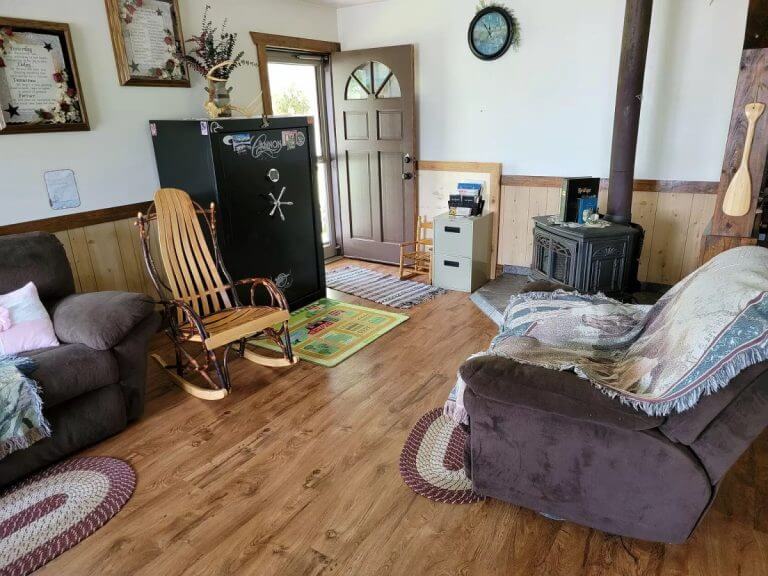
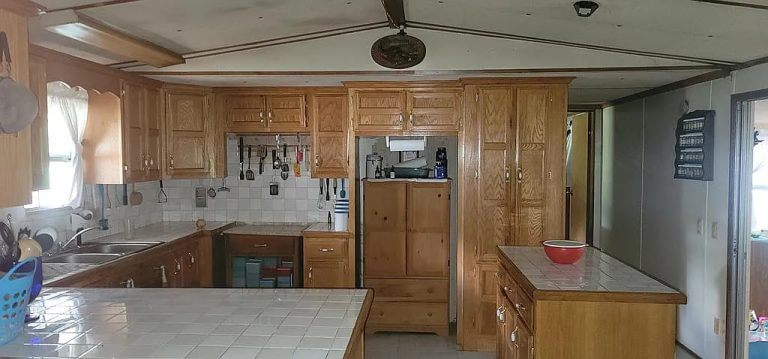

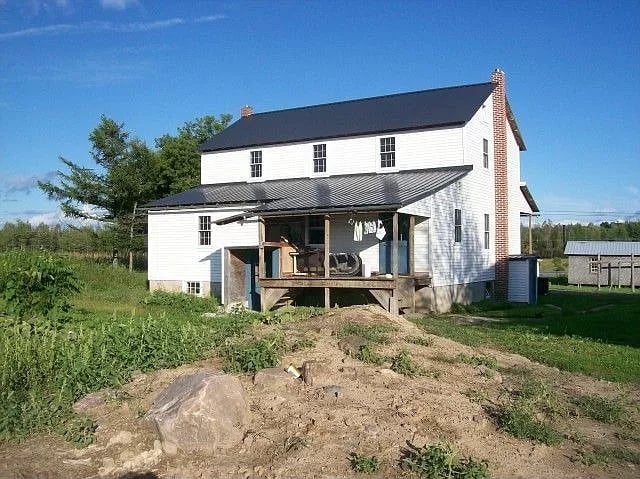
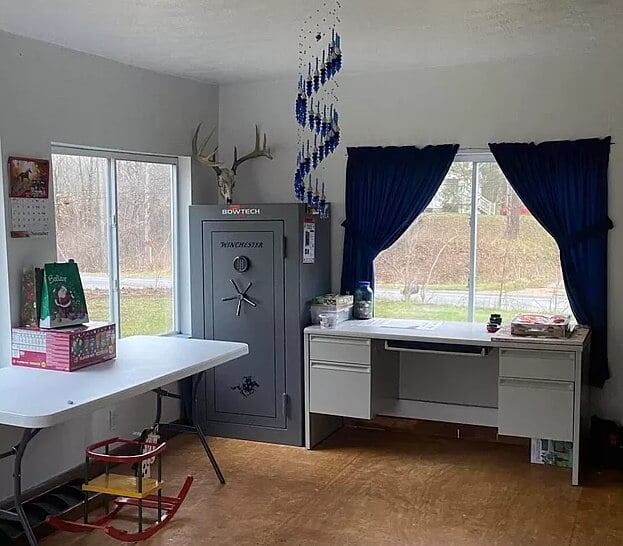
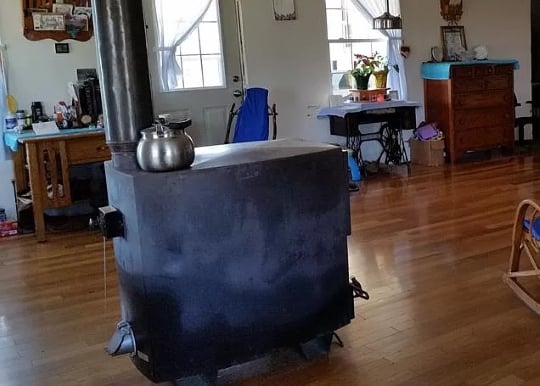
The House
It all looks quite cozy, neat and clean. I wonder if the canned stuff beneath the antlers might be a meat of some kind. I recall my grandmother mentioning that slaughtering a hog is an all day affair of processing the various cuts of pork, including canning. In a way it’s surprising that few, if any, of these Amish farmhouses have smokehouses. If the meat wasn’t canned it was smoked somehow, especially the cuts that became ham and bacon. I have been told that knowing how to cure meats that way is a skill, part of which requires knowing how to create a smoldering flame that will not ignite everything else and burn the smokehouse down plus knowing what types of wood or other combustibles can be used. There must be Amish people who know how to do it correctly.
The picture of the buggies made me wonder how long it takes to take the horse from its stall and hitch it to the buggy if someone needed to go somewhere. Are sleighs ever used in winter? Who makes the buggies and where are they made? After returning home, does the horse need to have a blanket put on it or if it is wet should it dry off first? How often are horses shoed an who does it? Where do the Amish get their horseshoes?
You do see some use of sleighs in the right conditions though I wouldn’t say it’s especially common. Larger Amish settlements have buggy shops where Amish make and repair buggies. Smaller ones without a shop would need to get their buggy from a different settlement. It’s similar with Amish farriers, who handle the shoeing (might also be done by non-Amish). I understand it’s roughly every 6 weeks that the hoof needs trimming.
Mystery Jars
My first thought on the mystery jars was canned meat, but there seems to be more liquid than I would expect, so possibly a soup? The jars on the same shelf on the far right look more like canned meat to me.
I’m also curious about the jars that look almost clear with just liquid, perhaps just a stock or broth?
Very nice pictures.
The jars on far right do look like canned meat. I recently got a jar of canned bacon from an Amish family but I don’t think that’s it here. As you can probably tell I’m not a specialist on canned meat but the bacon was delicious.
Canned meat
My grandfather and great uncle used to get a hog every year to raise and butcher. My Dad told me when he was growing up that they used to can the pork in layers of lard to store it without refrigeration.
Horses
I just googled the question “whether horses can get fleas”–apparently they can, but a healthy horse seldom is infested with fleas–maybe that is partly what brushing and combing the horse is for. I look at these pictures of farmhouses and the outbuildings and I begin to think of all the work involved in maintaining the whole operation, especially when people like the Amish do a great deal of labor the “old fashioned” way without electricity. I can’t imagine how they deal with their animals having fleas–maybe they get in a good supply of flea powder(???). Are the horses allowed to graze in the pasture so they aren’t in the stall all the time?
They do go out to graze though I’m not sure how the winter schedule compares. Horses apparently also graze in winter, and even in snow, but tbh I haven’t paid a lot of attention to what’s customary with Amish-owned horses in winter.
Winter horse care
I’m not Amish, but I grew up with horses. Horses are adapted to live outdoors in winter. They grow a shaggy winter coat to help keep them insulated. The digestion of hay helps them stay warm also. If it’s windy a barn with a “ run – in” area is sufficient in the harshest winter weather. The most important thing in winter is open water. If their water source freezes up, the can’t get enough moisture from snow to digest all the hay and will “ colic” . Not like a baby, horses can die from a twisted intestine due to impaction colic. As far as fleas, I never heard of a horse with fleas, now ticks are a different story. In the southern US most owners treat their horses to prevent ticks. I saw a horse in Missouri once covered with swollen up ticks. Poor thing.
In the jars under the antlers?
From experience with my friends and family, I would say under the antlers on the left side are jars of chunked chicken or turkey breast, canned in broth. To the right of those are jars of just broth. This broth is great to use for soup making, and to cook rice or noodles in. I have some similar looking jars myself.
Gotcha – sounds good to me. The left jars do look like some type of meat suspended in broth. Nice to have a good store of that in cold weather (or when under the weather:))